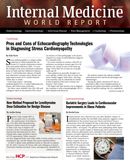Publication
Article
Internal Medicine World Report
Triple Therapy for Hepatitis C Infection: Bacterial Infection Risk Rises, Changes
Author(s):
Patients who have HCV infection are at high risk for arthralgia, myalgias, pruritus, neuropathy, and decompensated livers. Until recently the sole available treatment was interferon. After the US Food and Drug Administration (FDA) approved ribavirin, patients who took ribavirin plus interferon responded better. Now, the FDA has approved a small selection of oral antivirals to treat hepatitis C.

A good adjective to describe hepatitis C virus (HCV) infection is “tricky.” Many Americans are infected and don’t know it, and are chronic carriers of the virus. Patients who have HCV infection are at high risk for arthralgia, myalgias, pruritus, neuropathy, and decompensated livers. Until recently the sole available treatment was interferon. After the US Food and Drug Administration (FDA) approved ribavirin, patients who took ribavirin plus interferon responded better. Now, the FDA has approved a small selection of oral antivirals to treat hepatitis C. Collectively, these drugs successfully induce sustained virologic response in more than 90% of patients.
Studies showed that HCV-infected patients who have comorbid HCV-related cirrhosis who receive double therapy (interferon and ribavirin) are at elevated risk of bacterial infections. Recent guidelines recommend adding a protease inhibitor (telaprevir or boceprevir, called triple therapy) to the interferon and ribavirin regimen to increase the likelihood of sustained virologic response. A team of European researchers, curious about how infection rates might be affected, set out to compare infection rates between treatments. Their study appeared in the October 2014 issue of the Journal of Hepatology.
Their findings are based on a retrospective analysis of prospectively collected data. They established 2 cohorts. In the first, 167 with HCV-related cirrhosis received triple therapy (Cohort A). In the second, 81 similar patients received double therapy (Cohort B).
Triple therapy was associated with a significantly higher infection rate (25%) compared to double therapy (9%). Patients who received double therapy; however, were more likely to develop respiratory tract infections (12%) than those on triple therapy (1%).
The authors noted that adding a protease inhibitor to interferon and ribavirin increases infection risk. They hypothesized that protease inhibitors may affect neutrophils and thus change the typical infection pattern, but additional studies will be needed to determine underlying mechanisms. They did not recommend prophylactic antibiotics routinely, but encouraged close monitoring for signs and symptoms of bacterial infection.






